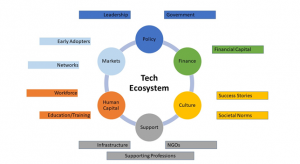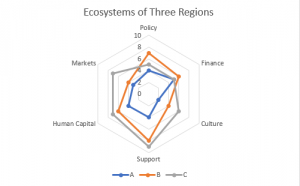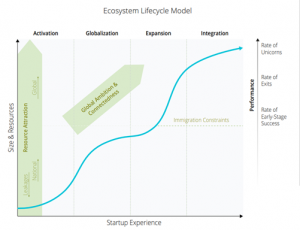What is business ecosystem?
2018-05-16
What is a business ecosystem?
The term “ecosystem” emerged from the environmental movement as a way to understand the interconnectness of the natural environment. If we add or take away an element of an ecosystem, such as a type of grass or tree, the other plants, insects, and animals may be affected positively or negatively. Everything is connected.
Similarly, a business ecosystem is a regional collection of inter-connected actors, organizations, and environmental factors that work together to support a grouping of businesses. Perhaps the most studied ecosystem is Silicon Valley in California. Elements of that ecosystem include universities, venture capitalists, prototyping resources, cultural values, and a warm climate.
There are different types of ecosystems. For example, Silicon Valley is highly effective at supporting a specific set of industry clusters, including Internet, bio-tech, software, semiconductors, computers, and telecommunications. The Valley’s ecosystem helps companies in those clusters turn scientific discoveries from around the world into products for global markets.
Other types of clusters have different goals. For example,
Innovation ecosystems can support the birth of new ideas for all sectors – for large companies and small, for the arts, medicine, sciences, or entertainment.
Startup ecosystems help entrepreneurs assemble a team of people to get funding for an idea, launch a prototype, and survive a growth tornado.
Sub-systems of an ecosystem can develop a life of their own.
The venture capital subsystem of Silicon Valley now funds startups in China, India, and Europe.
The intellectual property subsystem of Silicon Valley helps patent new technologies developed in research centers and businesses in much of western United States.
What are the elements of the typical business ecosystem?
This diagram illustrates an ecosystem that would support technology-based enterprises.

Ideally, an ecosystem is strong in all of the elements. When a particular service is not available in a region, the companies may source the services from other regions or build the service internally.
The above framework is useful for comparing the ecosystems of different regions. A spider diagram can point out weaknesses and areas for improvement.

How do business ecosystems work?
The key function of an ecosystem is networking. In the mid-Twentieth Century, businesses had their own ecosystems that connected internal functions with their supply chain. By the end of the 20th Century, with the help of the Internet and e-commerce services, companies became smaller and more specialized. Today, companies focus on developing a set of skills or intellectual property and out-source everything else, from manufacturing to human resources. Workers move from project to project while simultaneously taking classes to advance their skills and learn new technologies and project management tools.
Technology suppliers tend to specialize in serving the markets that are the major exporters from the region. Silicon Valley has many companies that make highly sophisticated equipment for the semiconductor industry that resides there. Other companies make analytical instruments that support the local bio-tech industry.
Ecosystems do best when there is an easy flow of ideas around the community. Support organizations train workers in the latest technologies demanded by employers, interest groups organize meetups and hackathons, social media are used to promote events and share stories, job listings help workers find new projects before their current project ends. Successful entrepreneurs “give back” by mentoring new entrepreneurs and forming Angel Investor clubs. There is a “pay-it-forward” culture and a feeling that “we are all in this together.”
Strong ecosystems are characterized by a high degree of trust. Surrounded by their competitors, companies learn to simultaneously compete, cooperate, collaborate, work with each other as customers. Trust is developed through personal connections, clear rules, and enforcement of the rules. Business leaders work together to identify and address barriers to success for their industry.
Business ecosystems evolve as they mature. The following diagram is based on research by Global Startup.

What are the benefits of having a healthy business ecosystem?
Even in the age of the Internet, place matters. There continue to be strong benefits to personal connections, having suppliers close by to work out problems, having access to workers who know your industry, and knowing the needs of your customers because you run into them in the coffee shops and at regular industry events. A strong ecosystem provides competitive advantage to the participants. They are better able to see changes on the horizon, they feel the pressure of competitors as they learn from them, they are more nimble, able to adapt, minimize losses, and grasp new opportunities.
With a healthy ecosystem, the whole community supports the industry. Think of Hollywood in California, where there is tremendous support from local governments and whole families work for “the industry.” Schools partner with businesses to prepare the workforce, government agencies give preference to local suppliers, transportation and housing are planned with the needs of the local clusters in mind, and everyone celebrates the successful enterprises and entrepreneurs.
It is exciting to work and live in a strong ecosystem. There is spirit, there are challenges, there are new ideas everywhere. A strong ecosystem attracts a talented workforce and investors. They, in turn, make the ecosystem even stronger and more attractive for others.
For more information about business ecosystems:
Global Clusters of Innovation: Lessons from Silicon Valley (video, 3 minutes)
What is a Tech Ecosystem, 2016, Bitetech
Global Startup Ecosystem Report, 2018, 150 pages. By Startup Genome
Canada’s AI Ecosystem report, 2018
Want an Innovation Ecosystem? Copy This One Part of Silicon Valley Culture, Steve Blank, Stanford University
Creating a Twentieth Century Technical Community: Frederick Terman‘s Silicon Valley, AnnaLee Saxenian, UC Berkeley